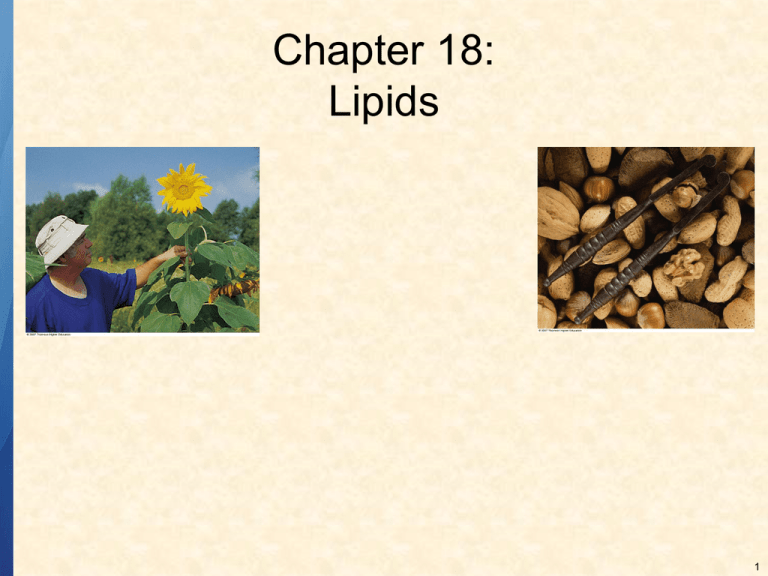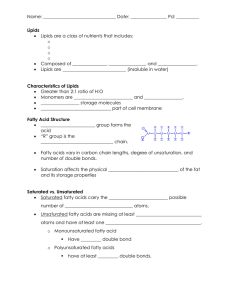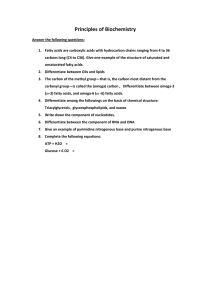Chapter 18: Lipids 1
advertisement

Chapter 18: Lipids 1 IMPORTANT FUNCTIONS OF LIPIDS • • • • Protective wax coatings found on some plants Energy-rich compounds with low densities Storage form of energy for plants and animals Structural components, especially in cellular membrane formation 2 LIPID • A biological compound that is soluble only in nonpolar solvents. 3 FATTY ACIDS • Building blocks of many lipids • Long chain carboxylic acids 4 FATTY ACIDS, cont. • In water, fatty acids will form micelles. 5 FATTY ACIDS – COMMON CHARACTERISTICS • • • • Usually straight chains (no branching) Sizes usually range from C10 to C20 Usually have an even number of carbons Can be saturated (no C=C bonds) or unsaturated (has C=C bonds, usually in the cis configuration) • Examples of saturated, monounsaturated, and polyunsaturated fatty acids containing 18 carbon atoms: 6 FATTY ACID – MOLECULAR SHAPES • C=C causes “kinking” of the carbon chain 7 FATTY ACIDS – MOLECULAR SHAPES, cont. • Fatty acids with C=C bonds cannot pack closely together because of shape. This leads to decreased intermolecular attractions and lower melting points. • Fatty acid melting points decrease as the number of C=C bonds increases. • Most unsaturated fatty acids are liquids at room temperature. 8 ESSENTIAL FATTY ACIDS • Those needed by the body, but not synthesized within the body in adequate amounts. • For humans, linoleic and linolenic acid are essential, but easily obtainable from plant and fish oils. 9 STRUCTURE OF FATS AND OILS • Fats Usually from animal sources Solids at room temperature Contain a high degree of saturated fatty acids • Oils Usually from plant and fish sources Liquids at room temperature Contain more unsaturated fatty acids 10 STRUCTURE, cont. • Fats and oils are triglycerides (triglycerols) which are triesters of glycerol. 11 STRUCTURE, cont. • An example of the esterification process: 12 REACTIONS OF FATS AND OILS • Hydrolysis – important for fat and oil digestion 13 REACTIONS, cont. • Saponification – the commercial production of the salts of fatty acids (soaps) 14 REACTIONS, cont. • Hydrogenation – decreases the degree of unsaturation, used to make margarines from oils 15 WAXES • Esters of fatty acids and long chain alcohols Water insoluble and not easily hydrolyzed Often found in protective coatings 16 PHOSPHOGLYCERIDES • A phospholipid that contains an alcohol (usually an amino alcohol) 17 IMPORTANT PHOSPHOGLYCERIDES • Lecithins Contain the amino alcohol choline Important cell membrane component Emulsifying agent • Cephalins Contain ethanolamine or serine as the alcohol Found in most cell membranes, especially brain tissue 18 SPHINGOLIPIDS • Sphingolipids contain sphingosine rather than glycerol. • Two types of sphingolipids exist: •Sphingomyelin contains a phosphate and choline group. It is found in the myelin sheath surrounding nerve cells. •Glycolipids contain carbohydrates unit. They are often called cerebrosides because of their abundance in brain tissue. 19 SPHINGOLIPID STRUCTURE 20 CELL MEMBRANES • Prokaryotic Cells – simple unicellular organisms with no internal membrane structures • Eukaryotic Cells – cells containing membrane-enclosed organelles, particularly a nucleus 21 MEMBRANE STRUCTURE • Most are 60% lipid, 40% protein • Lipids in membranes: phosphoglycerides, sphingomyelin, and cholesterol • Lipids are organized in a bilayer with hydrophobic (long carbon chain) portions inside and hydrophilic (polar groups) exposed to the water environment. 22 FLUID MOSAIC MODEL OF MEMBRANE STRUCTURE 23 STEROIDS A broad class of compounds that have the same structural feature: Like all lipids, steroids are soluble in nonpolar solvents. 24 STEROIDS, cont. • Cholesterol – the most abundant steroid in the human body Essential component of cell membranes Precursor of other important steroids Synthesized by liver and present in foods Strong correlation between cholesterol blood levels and atherosclerosis 25 STEROIDS, cont. • Bile salts – bile is produced by the liver, stored in the gallbladder, and emptied into the intestine Bile salts emulsify lipids in the intestine, breaking apart lipid globules Increased surface area allows lipids to be more easily hydrolyzed 26 STEROID HORMONES • Hormone – a chemical messenger secreted by specific glands and carried through the blood to a target tissue, where it triggers a particular response • There are two major categories of steroid hormones: adrenocorticoid hormones and sex hormones. 27 ADRENOCORTICOID HORMONES Produced by the adrenal glands Two classes: • Mineralocorticoids – regulate the concentration of ions in bodily fluids Aldosterone – increases absorption of Na+ and Cl• Glucocortiocids – enhance carbohydrate metabolism Cortisol – increases glucose and glycogen concentrations in the body 28 SEX HORMONES • Androgens – Male sex hormones produced by testes, including testosterone • Estrogen and Progesterone – female sex hormones produced by ovaries, including estradiol and estrone (the most important estrogens) 29 PROSTAGLANDINS • Cyclical compounds synthesized from arachidonic acid • Similar to hormones in that they are intimately involved in a host of body processes • Involved in almost every phase of reproduction • Participate in blood clotting 30 THERAPEUTIC POTENTIAL OF PROSTAGLANDINS • PGE2 and PGF2 induce labor and used for therapeutic abortion in early pregnancy • PGE2 in aerosol form used to treat asthma - opens up bronchial tubes by relaxing the surrounding muscles • Others inhibit gastric secretions and used to treat peptic ulcers • Many researchers believe that when they are fully understood, prostaglandins will be found useful for treating a much wider variety of ailments 31






